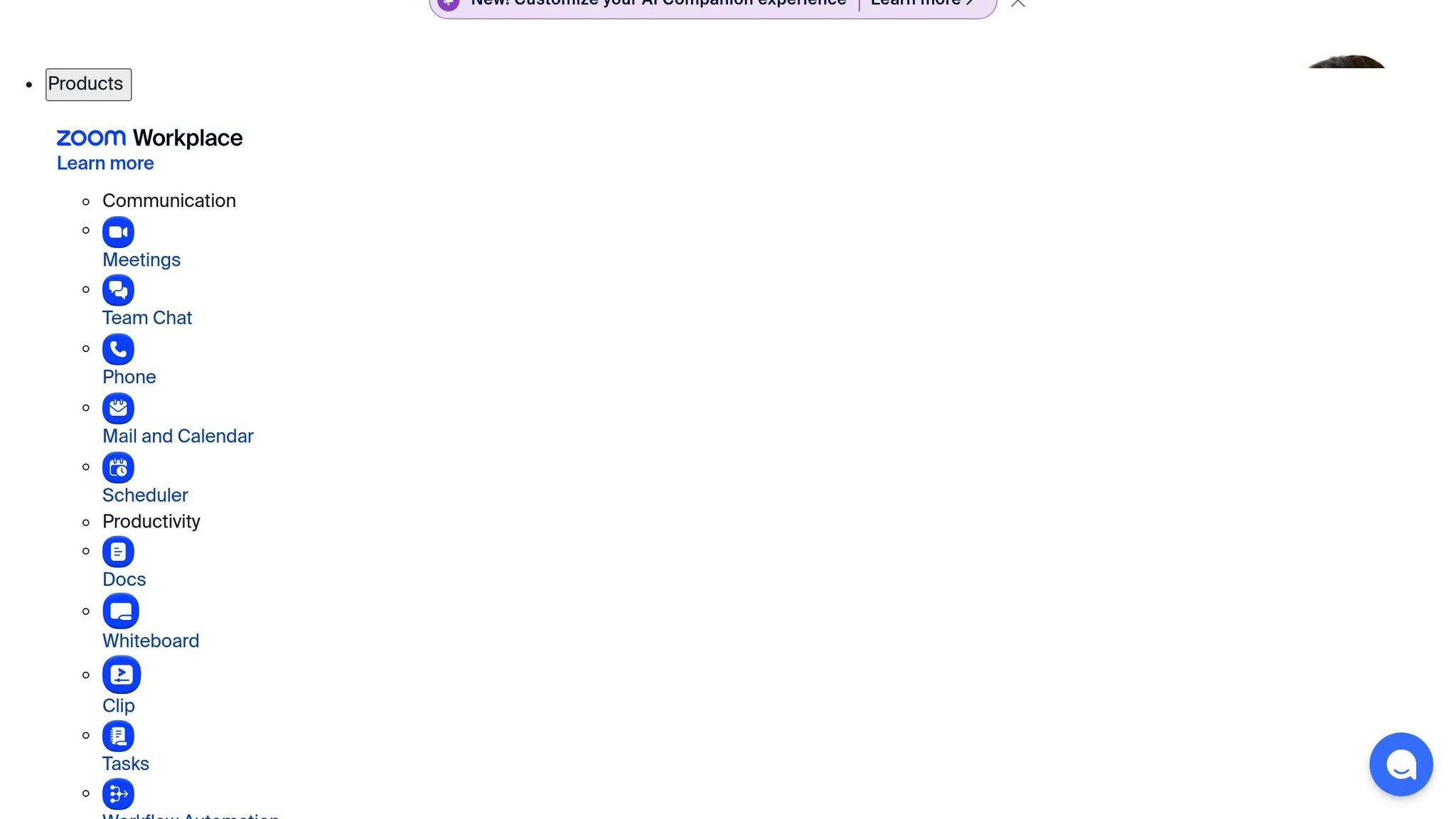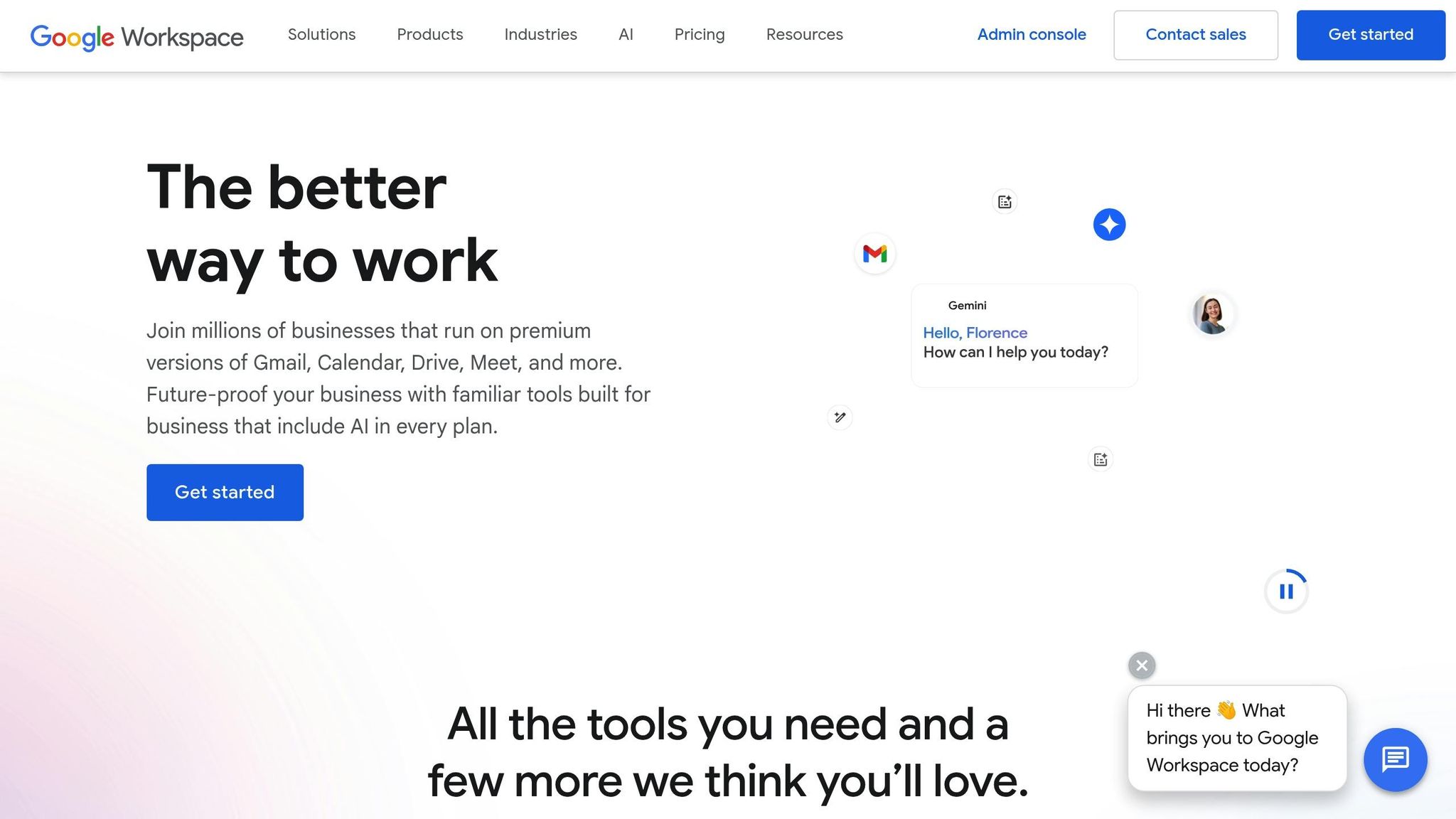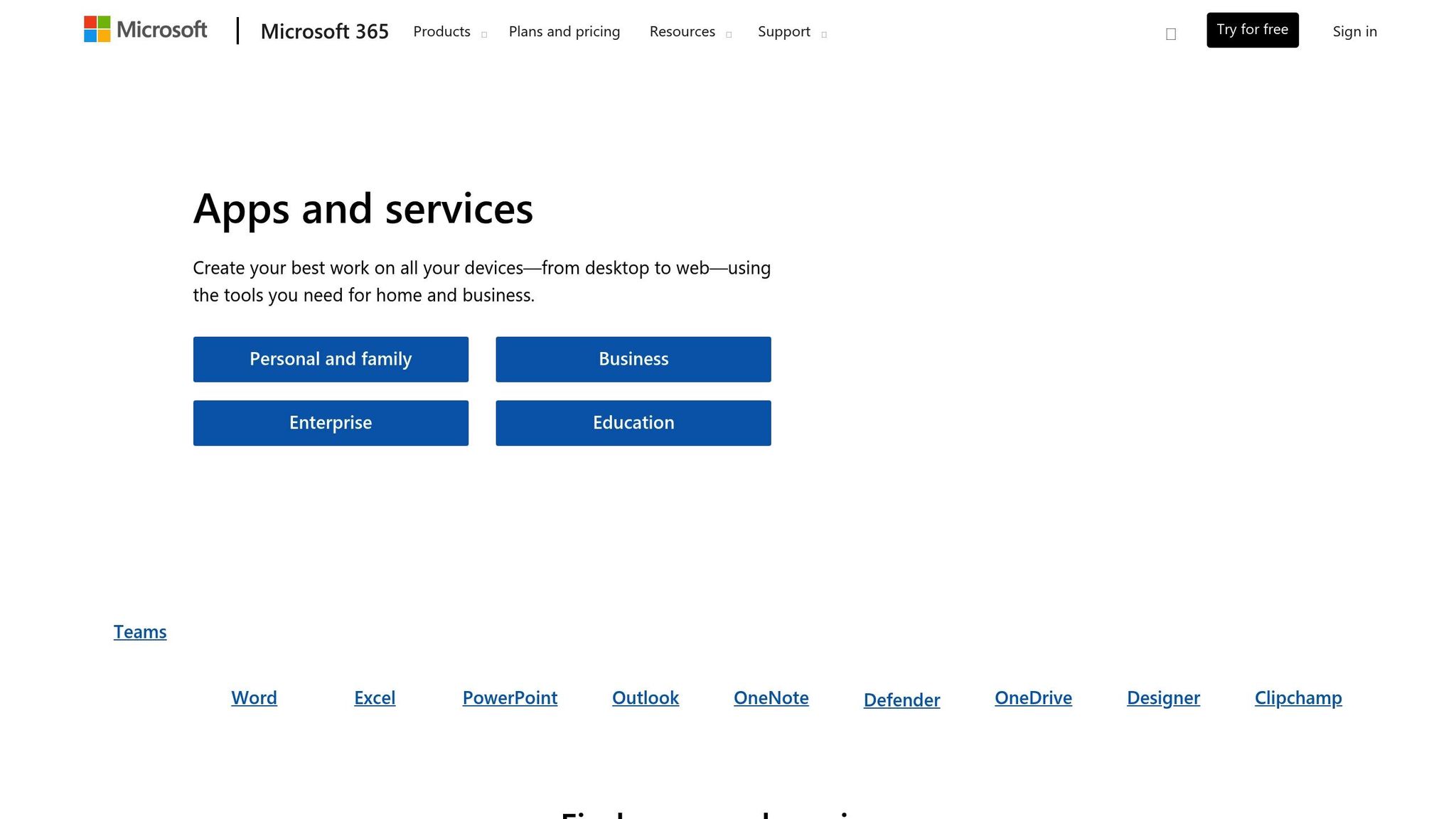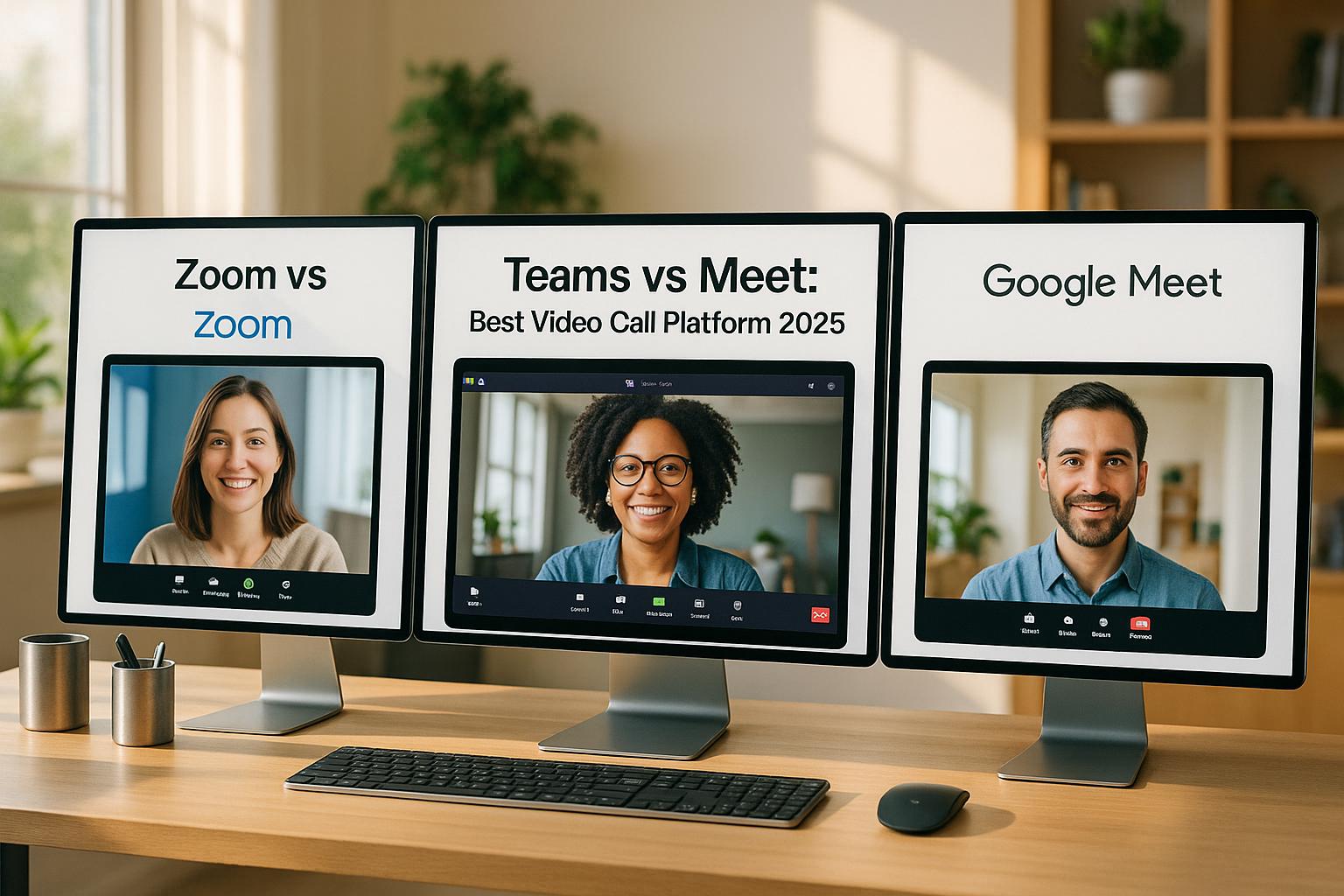Which video call platform is best for you in 2025?
Here’s the quick answer:
- Zoom: Best for high-quality video, webinars, and flexibility.
- Microsoft Teams: Perfect for Office 365 users and workplace collaboration.
- Google Meet: Ideal for Google Workspace users and simple browser-based meetings.
Quick Comparison Table:
| Feature | Zoom | Microsoft Teams | Google Meet |
|---|---|---|---|
| Free Plan Participants | 100 | 100 | 100 |
| Paid Plan Participants | Up to 1,000 (Enterprise) | Up to 300 (Business); 20,000 (listen-only) | Varies by plan |
| Best For | Webinars, flexible teams | Office 365 integration | Google Workspace integration |
| Starting Price | $12.49/user/month (Pro plan) | $4/user/month (Essentials) | $6.30/user/month (Starter) |
Each platform has strengths tailored to different workflows. Keep reading to find out which one fits your needs best!
Zoom vs Google Meet vs Microsoft Teams: Which is Better …

Platform Basics
Take a closer look at what each platform brings to the table.
Zoom: Focused on Video Meetings
Zoom is all about delivering dependable, video-first meetings. It’s trusted by 89 of the top 100 global universities and 8 of the 10 largest U.S. banks.
Here’s what Zoom offers:
| Core Feature | Details |
|---|---|
| Video Quality | Default 720p, with 1080p for Business/Enterprise plans |
| Meeting Capacity | Supports up to 1,000 participants (Enterprise level) |
| Cloud Recording | Includes 5 GB of storage with the basic plan |
| Security | Features 256-bit AES encryption for secure meetings |
Microsoft Teams: Built for Collaboration
Microsoft Teams combines video meetings with Office 365 tools, making it a natural fit for organizations already using Microsoft’s productivity suite.
Here’s what stands out:
| Feature | Details |
|---|---|
| Document Collaboration | Real-time editing with Office 365 apps |
| Chat System | Persistent messaging for individuals and groups |
| Cloud Storage | Offers 10 GB of storage on the basic plan |
| Meeting Tools | AI-powered video with support for 1080p quality |
Google Meet: Simplified for Google Workspace

Google Meet focuses on easy conferencing and integrates seamlessly with Google Workspace. It’s a great choice for organizations already using Gmail, Google Drive, and other Google tools.
Notable features include:
- Direct access via Gmail and Google Calendar
- Easy document sharing through Google Drive
- Built-in security measures
- Compatibility across devices and platforms
Each platform has its own strengths: Zoom shines in video conferencing, Teams enhances collaboration within Office 365, and Google Meet simplifies Google Workspace integration. Upcoming sections will dive into advanced features and tips for choosing the right solution.
Feature Comparison
Let’s break down how these platforms perform in key areas of video conferencing.
User Limits and Access Options
Participant limits and access methods vary across free and paid tiers for each platform:
| Feature | Zoom | Microsoft Teams | Google Meet |
|---|---|---|---|
| Free Plan Participants | 100 | 100 | 100 |
| Paid Plan Participants | Business: 300 Enterprise: Up to 1,000* |
Home: 300 Business: 300 |
Varies by plan |
| Large Event Support | Up to 1,000 with add-on | Up to 20,000 (listen-only) | N/A |
*Note: Enterprise plan requires an add-on for 1,000 participants.
Microsoft Teams stands out with its ability to host up to 20,000 listen-only participants, making it a strong choice for large-scale events. Once participant limits are set, the next step is understanding how meeting roles are handled by each platform.
Meeting Control Features
The way each platform manages meeting roles is just as important as participant capacity. Here’s how they compare:
- Microsoft Teams offers three roles:
- Organizer: Has full control over the meeting, including breakout rooms and muting participants.
- Co-organizer: Shares most of the organizer’s permissions.
- Presenter: Can share content and manage Q&A sessions.
- Zoom provides these roles:
- Host: Has complete control over the meeting.
- Co-host: Helps manage participants during the meeting.
- Alternative host: Can start and manage meetings if the host is unavailable.
These differences influence how teams assign responsibilities during meetings.
Software Integration Options
Integrations play a big role in improving workflows and managing costs.
"Zoom was cheaper than Teams, which is one of the reasons we switched away from Microsoft Teams Phones to Zoom Phones. But more importantly, when you’re consolidated on Zoom, your Zoom Phone won’t ring when you’re in a meeting. It knows that you’re busy so the phone won’t disrupt you."
– Dan Stine, Director of Design Technology, Lake|Flato Architects
Here’s a quick look at integration capabilities:
- Microsoft Teams integrates seamlessly with the Office 365 suite.
- Zoom connects with 2,798 apps through its App Marketplace.
- Both platforms support tools like Adobe Creative Cloud, ClickUp, GitHub, and Google applications.
Cost comparison:
- One-time deployment & training costs per user:
- Zoom Workplace: $44
- Microsoft Teams: $68
- Annual operating costs per user:
- Zoom Workplace: $275
- Microsoft Teams: $577
These numbers highlight Zoom’s lower long-term costs, especially for organizations looking to optimize their budgets.
sbb-itb-b7e60f3
Platform-Specific Features
Each video conferencing platform brings its own strengths to the table, offering tools tailored to different needs.
Zoom: Tools for Webinars and Events
Zoom stands out for its robust webinar features, making it a go-to choice for large-scale virtual events. The platform allows webinars to run for up to 30 hours with no streaming delays.
Here’s a breakdown of its webinar capabilities:
| Feature | Capacity | Pricing |
|---|---|---|
| Interactive Video Panelists | Up to 1,000 | Varies by plan |
| Maximum Attendees | Up to 1 million | Custom pricing |
| Zoom Sessions | Up to 500 | $114.99/month |
| Zoom Webinars | Up to 500 | $690/year |
"With this new and expanded capacity for webinars, Zoom is opening new opportunities for innovative organizations".
Zoom also includes an AI Companion that supports smart messaging and image generation. Hosts benefit from detailed analytics covering registration, attendance, and engagement, helping them refine their webinar strategies.
Microsoft Teams: Integrated with Office 365

Microsoft Teams focuses on improving workplace collaboration, leveraging its seamless integration with Microsoft 365. According to Forrester research, Teams can save workers up to 4 hours per week by reducing the need to switch between apps and centralizing access to information.
When you create a team, the platform automatically generates:
- A SharePoint Online site
- An Office 365 Group
- An Exchange Online mailbox and calendar
- A OneNote notebook
These features simplify workflows and centralize project management, making Teams a key tool for remote work in 2025.
Google Meet: Accessibility and Simplicity
Google Meet emphasizes easy access and a user-friendly experience. Key features include:
- Browser-based access without requiring software downloads
- Built-in recording and transcription tools
- Integration with Google Workspace apps
- Encryption for secure communications
The platform’s Gemini AI enhances meetings with real-time captions and automated note-taking, which is especially helpful for international teams. Additionally, Google Meet supports hardware compatibility with major manufacturers and allows users to join Cisco Webex and Zoom meetings directly from Google Meet devices.
Platform Selection Guide
Explore scenarios where each platform stands out. Building on feature comparisons, these examples help identify the platform that suits your needs best.
When to Choose Zoom
Zoom is ideal for users who value high-quality video and flexibility. With a 4.5/5 rating on G2, Zoom is a strong choice in these situations:
| Use Case | Why Zoom Stands Out |
|---|---|
| Webinars & Training | High video quality makes it perfect for these events |
| Mixed Environment Teams | Performs reliably across different network conditions |
| Third-party Integration | Works with a wide range of business tools |
| Standalone Solution | Functions effectively as a dedicated video platform |
"Between its superb core video conferencing features and advanced collaboration tools, Zoom is the best all-around video conferencing platform we’ve tested." – Neil McAllister, PCMag
Zoom Pro plans start at $12.49 per user per month.
When to Choose Microsoft Teams
If your organization relies on Microsoft tools, Teams is a natural fit. With a 4.4/5 rating on G2, it’s designed for seamless integration with Microsoft 365. Teams works best in these scenarios:
| Scenario | Benefits |
|---|---|
| Enterprise Security | Transparent privacy policies |
| Document Collaboration | Real-time editing with Office 365 |
| Unified Communications | Combines chat, calls, and meetings in one platform |
| Compliance Requirements | Includes advanced security features |
"Die-hard Microsoft shops should take note: If you’re already using Teams – and particularly if you’re a Microsoft 365 customer – it might be all the video conferencing software you need." – Neil McAllister, PCMag
Teams Essentials plans start at $4 per user per month.
When to Choose Google Meet
For teams already using Google Workspace, Google Meet is a seamless option. With a 4.6/5 rating on G2, it’s built for Google-centered workflows. Google Meet is most effective in these scenarios:
| Environment | Key Advantages |
|---|---|
| Browser-Based Work | No need to download software |
| Google Workspace Users | Integrates easily with Gmail and Calendar |
| Low-Bandwidth Settings | Optimized for slower internet connections |
"Google Meet is a no-brainer if you use Google Workspace for online collaboration. It’s very reliable and easy to use." – Neil McAllister, PCMag
Google Meet Business Starter plans begin at $6.30 per user per month.
Conclusion: Making Your Choice
Pick a platform that aligns with your needs and tech setup in 2025. Based on the detailed comparisons above, here’s a quick guide to help you decide:
| Priority | Platform | Why It Stands Out |
|---|---|---|
| Video Performance | Zoom | Top-tier video and audio quality for presentations |
| Microsoft 365 Tools | Microsoft Teams | Smooth integration with Office apps |
| Google Workspace Sync | Google Meet | Works seamlessly with Gmail and Calendar |
| Enterprise Security | Microsoft Teams | Advanced compliance and security options |
| Budget-Friendly | Microsoft Teams Essentials | Affordable at $4/user/month |
Choose the option that fits your main use case. For example:
- Client Presentations or Training: Zoom’s high-quality video is worth the $12.49/month.
- Microsoft 365 Users: Teams’ integration justifies its higher cost.
- Quick, Browser-Based Meetings: Google Meet is a simple, efficient choice.
Each platform has strengths tailored to different workflows:
- Enterprise Users: Teams offers robust compliance and security.
- Freelancers: Zoom delivers dependable performance for client calls.
- Small Teams: Meet is easy to set up and use, straight from your browser.
All three platforms deliver solid performance, so the best choice depends on your specific needs. For more detailed setup guides and comparisons, check out our Remote Success Hub knowledge base.
FAQs
What should I consider when choosing between Zoom, Microsoft Teams, and Google Meet for video conferencing in 2025?
When deciding between Zoom, Microsoft Teams, and Google Meet for video conferencing in 2025, focus on video and audio quality, security features, and collaboration tools. High-definition video and clear audio are essential for seamless communication, while robust security – like end-to-end encryption and meeting password protection – helps safeguard sensitive information.
Ease of use is another critical factor. Intuitive interfaces minimize technical issues and training time, while features like screen sharing, real-time document editing, and virtual whiteboards enhance collaboration. Additionally, consider how well the platform integrates with your existing tools, such as project management or CRM software. Ultimately, your choice should align with your organization’s specific needs and tech ecosystem.
Which video call platform – Zoom, Microsoft Teams, or Google Meet – offers the best security for businesses in 2025?
All three platforms – Zoom, Microsoft Teams, and Google Meet – offer strong security features, but their focus and strengths differ slightly. Zoom includes end-to-end encryption, meeting access controls like passwords and waiting rooms, and robust authentication options such as SSO and two-factor authentication. Microsoft Teams, on the other hand, emphasizes enterprise-level security with data loss prevention policies, guest access controls, and compliance with standards like ISO 27001, SOC 2, and HIPAA. Google Meet provides encryption and secure meeting access, though its enterprise-specific security details are less emphasized.
For businesses, Microsoft Teams often stands out due to its extensive compliance certifications and enterprise-focused tools. However, Zoom remains a strong contender with its advanced encryption and customizable security settings. The best choice ultimately depends on your organization’s specific compliance needs and collaboration preferences.
Can I use third-party apps with Zoom, Microsoft Teams, and Google Meet? How do these integrations improve their functionality?
Yes, all three platforms – Zoom, Microsoft Teams, and Google Meet – allow integration with third-party apps, significantly enhancing their features and usability for remote work and collaboration.
- Zoom offers a wide range of integrations through its App Marketplace, enabling users to streamline tasks like scheduling, note-taking, or automating workflows. These integrations help create more engaging and efficient meetings by connecting Zoom with tools for project management, marketing, and team collaboration.
- Microsoft Teams integrates seamlessly with other Microsoft products, such as Outlook and OneDrive, as well as a variety of third-party apps. This makes it a powerful hub for team communication, file sharing, and productivity.
- Google Meet works effortlessly with Google Workspace apps like Calendar, Docs, and Drive. These integrations simplify meeting setup and make sharing information during virtual calls quick and intuitive.
By connecting these platforms with your favorite tools, you can customize your workflow, save time, and improve collaboration across teams.

